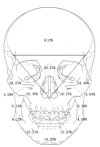Analysis of 126 hospitalized elder maxillofacial trauma victims in central China
- PMID: 25858086
- PMCID: PMC4523260
- DOI: 10.4317/medoral.20551
Analysis of 126 hospitalized elder maxillofacial trauma victims in central China
Abstract
Background: The aim of this study was to analyzed the characteristics and treatment of maxillofacial injuries in the elder patients with maxillofacial injuries in central China.
Material and methods: We retrospectively analyzed the characteristics and treatment of maxillofacial injuries in the patients over the age of 60 to analyze the trends and clinical characteristics of maxillofacial trauma in elder patients from the First Affiliated Hospital of Zhengzhou University (from 2010 to 2013) in central China and to present recommendations on prevention and management.
Results: Of the 932 patients with maxillofacial injuries, 126 aged over 60 years old accounting for 13.52% of all the patients (male:female, 1.74:1; mean age, 67.08 years old). Approximately 52% of the patients were injured by falls. The most frequently observed type of injuries was soft tissue injuries (100%), followed by facial fractures (83.05%). Of the patients with soft tissue injuries, the abrasions accounted the most, followed by lacerations. The numbers of patients of midface fracture (60 patients) were almost similar to the number of lower face fractures (66 patients). Eighty two patients (65.08%%) demonstrated associated injuries, of which craniocerebral injuries were the most prevalent. One hundred and four patients (82.54%) had other systemic medical conditions, with cardiovascular diseases the most and followed by metabolic diseases and musculoskeletal conditions. Furthermore, the study indicated a relationship between maxillofacial fractures and musculoskeletal conditions. Only 13 patients (10.32%) sustained local infections, of whom had other medical conditions. Most of the facial injuries (85.71%) in older people were operated including debridement, fixing loose teeth, reduction, intermaxillary fixation and open reduction and internal fixation (ORIF).
Conclusions: Our analysis of the characteristics of maxillofacial injuries in the elder patents may help to promote clinical research to develop more effective treatment and possibly prevent such injuries.
Conflict of interest statement
Figures
Similar articles
-
Analysis of maxillofacial injuries caused by the 2010 Yushu earthquake in China.Emerg Med J. 2012 Sep;29(9):761-4. doi: 10.1136/emermed-2011-200346. Epub 2011 Oct 13. Emerg Med J. 2012. PMID: 21998470
-
[Clinic analysis of 198 elder patients with maxillofacial fracture].Hua Xi Kou Qiang Yi Xue Za Zhi. 2018 Dec 1;36(6):671-674. doi: 10.7518/hxkq.2018.06.017. Hua Xi Kou Qiang Yi Xue Za Zhi. 2018. PMID: 30593116 Free PMC article. Chinese.
-
Analysis of 46 maxillofacial fracture victims in the 2008 Wenchuan, China earthquake.Oral Surg Oral Med Oral Pathol Oral Radiol Endod. 2009 Nov;108(5):673-8. doi: 10.1016/j.tripleo.2009.05.031. Epub 2009 Aug 28. Oral Surg Oral Med Oral Pathol Oral Radiol Endod. 2009. PMID: 19716718
-
Maxillofacial Trauma: Managing Potentially Dangerous And Disfiguring Complex Injuries.Emerg Med Pract. 2017 Apr;19(4):1-24. Epub 2017 Apr 1. Emerg Med Pract. 2017. PMID: 28362252 Review.
-
A review of paediatric maxillofacial injuries--a hospital-based study.SADJ. 2005 Mar;60(2):54, 56-7. SADJ. 2005. PMID: 15957345 Review.
Cited by
-
Cervical Spine Injuries and Maxillofacial Trauma: A Systematic Review.Saudi Dent J. 2021 Dec;33(8):805-812. doi: 10.1016/j.sdentj.2021.09.006. Epub 2021 Sep 14. Saudi Dent J. 2021. PMID: 34938019 Free PMC article. Review.
-
Fractures of the Craniofacial Skeleton in the Elderly: Retrospective Studies.Int J Environ Res Public Health. 2021 Oct 26;18(21):11219. doi: 10.3390/ijerph182111219. Int J Environ Res Public Health. 2021. PMID: 34769738 Free PMC article.
-
PATTERNS OF FACIAL FRACTURES AND ASSOCIATED SOFT TISSUE INJURIES: A RETROSPECTIVE STUDY ON 1007 PATIENTS.Acta Clin Croat. 2022 Nov;61(3):412-420. doi: 10.20471/acc.2022.61.03.06. Acta Clin Croat. 2022. PMID: 37492356 Free PMC article.
-
[Current therapy of atrophic edentulous mandibular fractures among elderly people].Hua Xi Kou Qiang Yi Xue Za Zhi. 2017 Aug 1;35(4):433-436. doi: 10.7518/hxkq.2017.04.017. Hua Xi Kou Qiang Yi Xue Za Zhi. 2017. PMID: 28853513 Free PMC article. Review. Chinese.
-
Incidence of maxillofacial fractures in motor vehicle accidents treated in Dubai.Saudi Dent J. 2021 Sep;33(6):348-354. doi: 10.1016/j.sdentj.2020.03.007. Epub 2020 Mar 18. Saudi Dent J. 2021. PMID: 34434038 Free PMC article.
References
-
- Mandel L. Hyposalivation: the roles of radioactive iodine and stapes surgery. J Oral Maxillofac Surg. 2013;71:e76–80. - PubMed
-
- Payne KF, Tahim A, Goodson AM, Colbert S, Brennan PA. A review of trauma and trauma-related papers published in the British Journal of Oral and Maxillofacial Surgery in 2010-2011. Br J Oral Maxillofac Surg. 2012;50:769–73. - PubMed
-
- Holton J, Chung WL, Herford A. Trauma surgery. J Oral Maxillofac Surg. 2012;70 11 Suppl 3:e162–203. - PubMed
-
- Bruckmoser E, Undt G. Management and outcome of condylar fractures in children and adolescents: a review of the literature. Oral Surg Oral Med Oral Pathol Oral Radiol. 2012;114(5 Suppl):S86–S106. - PubMed
Publication types
MeSH terms
LinkOut - more resources
Full Text Sources
Other Literature Sources




